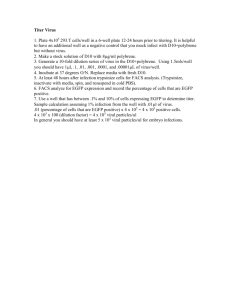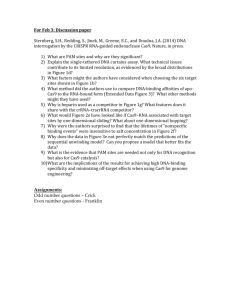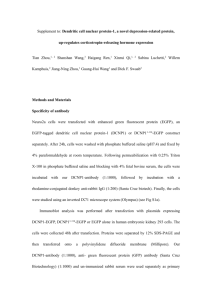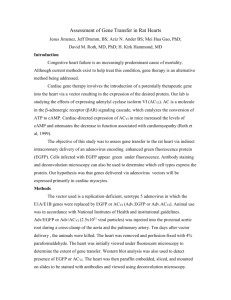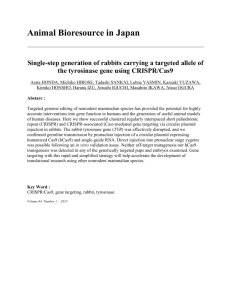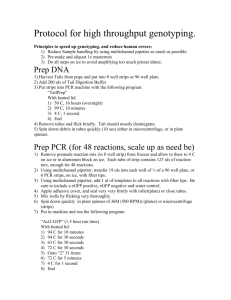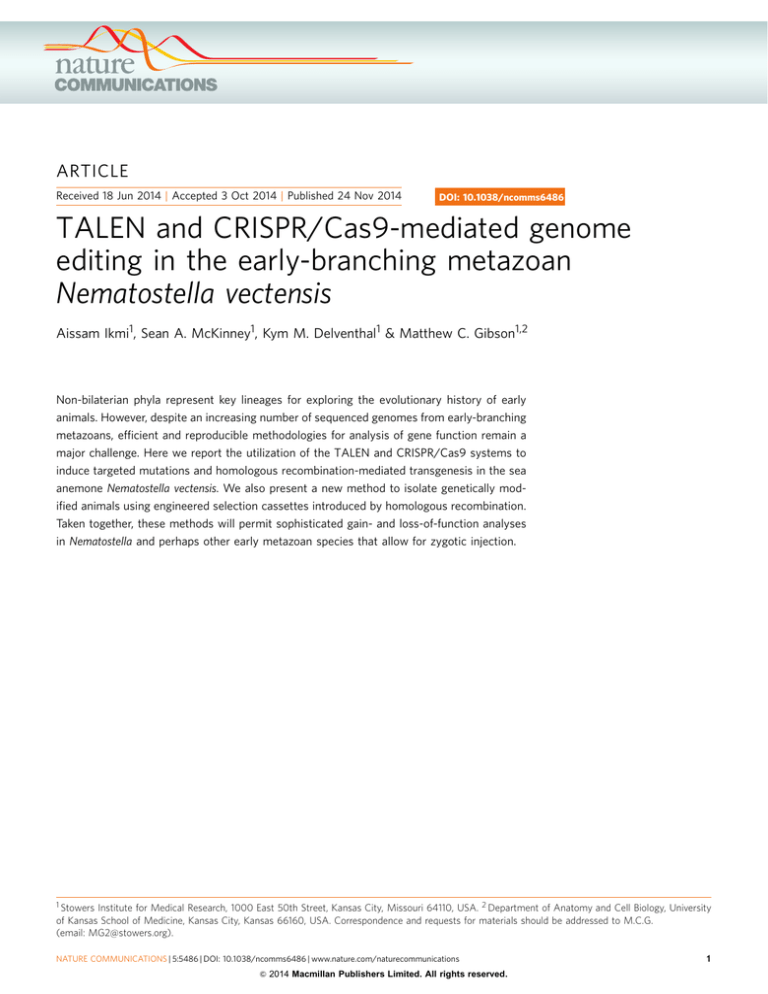
ARTICLE
Received 18 Jun 2014 | Accepted 3 Oct 2014 | Published 24 Nov 2014
DOI: 10.1038/ncomms6486
TALEN and CRISPR/Cas9-mediated genome
editing in the early-branching metazoan
Nematostella vectensis
Aissam Ikmi1, Sean A. McKinney1, Kym M. Delventhal1 & Matthew C. Gibson1,2
Non-bilaterian phyla represent key lineages for exploring the evolutionary history of early
animals. However, despite an increasing number of sequenced genomes from early-branching
metazoans, efficient and reproducible methodologies for analysis of gene function remain a
major challenge. Here we report the utilization of the TALEN and CRISPR/Cas9 systems to
induce targeted mutations and homologous recombination-mediated transgenesis in the sea
anemone Nematostella vectensis. We also present a new method to isolate genetically modified animals using engineered selection cassettes introduced by homologous recombination.
Taken together, these methods will permit sophisticated gain- and loss-of-function analyses
in Nematostella and perhaps other early metazoan species that allow for zygotic injection.
1 Stowers Institute for Medical Research, 1000 East 50th Street, Kansas City, Missouri 64110, USA. 2 Department of Anatomy and Cell Biology, University
of Kansas School of Medicine, Kansas City, Kansas 66160, USA. Correspondence and requests for materials should be addressed to M.C.G.
(email: MG2@stowers.org).
NATURE COMMUNICATIONS | 5:5486 | DOI: 10.1038/ncomms6486 | www.nature.com/naturecommunications
& 2014 Macmillan Publishers Limited. All rights reserved.
1
ARTICLE
NATURE COMMUNICATIONS | DOI: 10.1038/ncomms6486
T
he recent advent of genome-editing tools promises to
democratize the molecular-genetic interrogation of animal
biology, in both basic and biomedical applications. To date,
transcription activator-like effector nucleases1,2 (TALENs) and
the clustered regulatory interspaced short palindromic repeatsassociated endonuclease Cas9 (refs 3,4) (CRISPR/Cas9) have
been applied to edit the genome in cell culture5–7 and a few
select model organisms from the bilaterian clade8–11. Among the
non-bilaterians (Cnidaria, Placozoa, Porifera and Ctenophora),
experimental tools remain a limiting factor for functional studies,
restricting the available approaches to partial and imprecise gene
disruption via morpholinos, RNA interference, pharmacological
inhibitor experiments and correlative analyses of gene expression
patterns. Thus, for studies of early animal evolution and
development, genome-editing methods now present a transformative opportunity to manipulate gene function in vivo.
The genome of the cnidarian Nematostella vectensis was the
first to be sequenced among the early Metazoa12, revealing an
unexpected degree of genetic complexity in what was once
regarded as a ‘primitive’ animal. Combined with its phylogenetic
position, extensive regenerative capacity and relative ease of
laboratory spawning, Nematostella has become a highly attractive
model for comparative genomics and evolutionary developmental
biology13. Although morpholino-mediated knockdown14,
injection of messenger RNA (mRNA)15 and meganucleasemediated transgenesis16 methods have been applied in Nematostella, their utility is generally restricted to early embryonic
development or subject to considerable functional limitations.
Here, to expand the experimental toolkit in Nematostella while
establishing a proof of principle for all early metazoan systems,
we report methods to perform precise in vivo gene editing using
both TALEN- and CRISPR/Cas9-mediated homologous recombination. We first employ the TALEN and CRISPR/Cas9 systems
to generate targeted mutations in NvFP-7R, a locus encoding an
endogenous Nematostella red fluorescent protein17. Second, we
develop an efficient method to track genomic lesions in both
somatic and germline cells with selection cassettes introduced
through TALEN and CRISPR/Cas9-mediated homologous
recombination. Finally, using NvFP-7R as a landing site,
we establish a robust homologous recombination-mediated
transgenesis method for Nematostella.
Results
TALEN-mediated mutagenesis at the NvFP-7R locus. To
generate site-directed mutations likely to yield clear but nonlethal phenotypes, we targeted an endogenous Nematostella red
fluorescent protein (NvFP-7R) using the TALEN system. We
previously reported that NvFP-7R encodes a red fluorescent
protein that is specifically expressed in the oral pole of adult
polyps17 (Fig. 1a). We thus constructed a TALEN pair that
recognizes a target sequence within the obligate second exon of
NvFP-7R (NvFP-7R-TALEN; Fig. 1b). Taking advantage of the
fact that the Nematostella genome contains seven green
fluorescent protein (GFP)-like genes, we also used BLAST to
characterize putative off-target sites in NvFP5 and NvFP4. These
loci exhibited either two or six nucleotide mismatches in the
TALEN target site, respectively (Supplementary Fig. 1a), and thus
provided an internal control for TALEN specificity.
Following in vitro transcription from plasmid templates, we
microinjected equal amounts of both left and right TALEN
mRNAs into unfertilized Nematostella eggs (200 ng ml 1 each;
n ¼ 803). After fertilization, B54% of TALEN-injected embryos
survived to the primary polyp stage and appeared morphologically normal (Supplementary Table 1). To assay disruption of
NvFP-7R, we reared injected animals beyond the 12-tentacle stage
2
when the expression of the endogenous red fluorescence becomes
clearly visible17. Using a fluorescent dissecting microscope, we
identified a high percentage of adult polyps that showed either
mosaic (23%) or complete loss (18.7%) of the normal red
fluorescence (Fig. 1c; Supplementary Fig. 2; Supplementary
Table 1). In these cases, the disruption of red fluorescence was
most likely due to biallelic TALEN-induced mutagenesis in a
large population of cells. To confirm this, we cloned and
sequenced 500 base pairs of genomic DNA, including exon 2,
from two ‘red-less’ animals with no detectable NvFP-7R
expression. As expected, almost all sequenced NvFP-7R alleles
(80 and 100%) carried insertion/deletion mutations at the
TALEN target site (Fig. 1d). The spectrum of mutation events
recovered within individual red-less animals suggests that they
originated from independent TALEN-induced double-strand
break events followed by errors in non-homologous end
joining-mediated repair. Collectively, these findings demonstrate
that TALENs can efficiently generate targeted lesions in the
Nematostella genome, frequently disrupting both alleles in a large
number of somatic cells.
NvFP-7R is dispensable for Nematostella development. To
investigate the function of NvFP-7R in Nematostella, we performed phenotypic analyses of NvFP-7R mutants. At the cellular
level, the expression of NvFP-7R is restricted to the endodermal
cells between tentacles and the myoepithelial cells of the
mesenteries17 (Supplementary Fig. 3a–d), with a significant
accumulation of the protein in the contractile elements
(Supplementary Fig. 3e). In optical cross-sections through the
oral region, we observed that polyps exhibiting NvFP-7R loss-offunction were morphologically indistinguishable from wild-type
controls (Supplementary Fig. 3c,d). More specifically, we did
not detect any developmental defects in muscle filaments
(Supplementary Fig. 3e) or changes in their contractile
behaviour (Supplementary Fig. 3f; Supplementary Movies 1
and 2). Together, these results suggest that NvFP-7R is not
required for normal development or homeostasis of Nematostella
under laboratory conditions.
Germline transmission of TALEN-induced mutations. Using a
standardized protocol, Nematostella females can be induced to
spawn hundreds of eggs clustered in a gelatinous mass. To
determine whether TALEN-induced mutations were transmitted
through the germline of injected F0 females, we reared them to
sexual maturity and then genotyped unfertilized oocytes. By
sequencing exon 2 of NvFP-7R, we determined the nature and
frequency of TALEN-induced mutations present in the gametes.
We did not detect germline mutations in TALEN-injected
animals displaying wild-type expression of NvFP-7R (n ¼ 5).
In contrast, we documented germline transmission of induced
mutations in unfertilized eggs from 50% of red-less F0 females
(n ¼ 12; Supplementary Fig. 4a,b), with a frequency of NvFP-7R
mutation up to 80% (Supplementary Fig. 4c). These results
demonstrate efficient TALEN-induced mutations of the Nematostella germline. Importantly, they also illustrate how the presence of a visible marker can significantly increase the probability
of identifying founder animals. As a general strategy for TALENmediated mutagenesis, the use of visual selection cassettes could
greatly facilitate the isolation of genetically modified individuals.
TALEN-mediated homologous recombination at the NvFP-7R
locus. In a limited number of cases, TALEN-mediated homologous recombination has been used to insert exogenous DNA
into the genomes of Drosophila11, zebrafish8 and mouse18. To test
this approach as a means to insert a selection cassette in
NATURE COMMUNICATIONS | 5:5486 | DOI: 10.1038/ncomms6486 | www.nature.com/naturecommunications
& 2014 Macmillan Publishers Limited. All rights reserved.
ARTICLE
3–6 months
Adult
TALEN
primary target site
NvFP-7R
NATURE COMMUNICATIONS | DOI: 10.1038/ncomms6486
Oral pole
Primary polyp
Zygote
8 Days
Planula
Gastrula
NvFP-7R
E1
E2
E3
E5
TAGTAAAGATGCTATGAAGCTTCACTTTAAAATGGAGGGGTCCGTCA
Left target seq.
20 h
E4
Spacer
Right target seq.
3 Days
Wild type
Red-less
Mosaic
58.3%
Overlap
WT
(-5bp)
(-9/+4bp)
(-4/+2bp)
(-7bp)
(-5/+1bp)
(-12bp)
(-78bp)
23%
Red filter
Red filter
18.7%
Red filter
AGAGTCTTAGTAAAGATGCTATGAAGCTTCACTTTAAAATGGAGGGGTCCGTCAACGGACATTGCTTCGAGATCCAAGGAGTAGGAGAAGGGAAAGCAT
AGAGTCTTAGTAAAGATGCTATGAAGC-----TTTAAAATGGAGGGGTCCGTCAACGGACATTGCTTCGAGATCCAAGGAGTAGGAGAAGGGAAAGCAT
AGAGTCTTAGTAAAGATGCTATTCCA-----CTTTAAAATGGAGGGGTCCGTCAACGGACATTGCTTCGAGATCCAAGGAGTAGGAGAAGGGAAAGCAT
AGAGTCTTAGTAAAGATGCTATGAAGCT--GATTTAAAATGGAGGGGTCCGTCAACGGACATTGCTTCGAGATCCAAGGAGTAGGAGAAGGGAAAGCAT
AGAGTCTTAGTAAAGATGCTATGAAGC-------TAAAATGGAGGGGTCCGTCAACGGACATTGCTTCGAGATCCAAGGAGTAGGAGAAGGGAAAGCAT
AGAGTCTTAGTAAAGATGCTATGAAGC----ATTTAAAATGGAGGGGTCCGTCAACGGACATTGCTTCGAGATCCAAGGAGTAGGAGAAGGGAAAGCAT
AGAGTCTTAGTAAAGATGCTAT------------TAAAATGGAGGGGTCCGTCAACGGACATTGCTTCGAGATCCAAGGAGTAGGAGAAGGGAAAGCAT
AGAGTCTTAGTAAAGAT------------------------------------------------------------------------------GCAT
Exon 2 of NvFP-7R
Figure 1 | TALEN-induced mutations in NvFP-7R. (a) The life cycle of Nematostella. After fertilization, embryos undergo gastrulation and develop into
swimming planulae that give rise to four-tentacle primary polyps. Primary polyps begin feeding and grow to form 16-tentacle adults. At the 12-tentacle
stage (B1.5 months), Nematostella specifically express NvFP-7R at the oral pole (inset box). (b) Gene model of NvFP-7R showing the target site of
the NvFP-7R-TALEN pair in exon 2 (E2). TALEN-binding sites are underlined in green. The spacer sequence is underlined in black. (c) TALEN-injected
animals exhibit three phenotypes of NvFP-7R expression. The first phenotype appears normal (wild type). The second phenotype (mosaic) displays loss of
NvFP-7R expression in one or more domains and normal expression in others (white arrowheads). The third phenotype lacks any detectable expression
of NvFP-7R (red-less). The percentages of each phenotype are indicated (n ¼ 312). Dotted lines indicate the outline of the oral pole. Scale bar, 1 mm.
(d) Molecular characterization of NvFP-7R-TALEN-induced mutations recovered from a phenotypically Red-less F0 animal.
Nematostella NvFP-7R, we constructed a donor vector containing
two distinct selection markers flanked by one kilobase (kb) of left
and right genomic homology arms (Fig. 2a). The first selection
marker comprised the coding sequence for mCherry under the
control of the myosin heavy chain1 (MHC1) promoter, which
drives expression in muscle cells16 (MHC1-mCherry). The second
selection marker was a protein trap reporter designed to insert
enhanced GFP (eGFP) in frame with NvFP-7R exon 2 upon
successful integration (NvFP-7R::eGFP). Hypothetically, when
this dual reporter cassette integrates into the TALEN-exon2 target
site, we expect to see both: (1) stable expression of MHC1mCherry; and (2) replacement of the red fluorescence of NvFP-7R
by the expression of a green NvFP-7R::eGFP fusion protein at the
oral end of adult animals (Fig. 2b).
To determine the optimal concentration of donor DNA for
TALEN-mediated homologous recombination, we co-injected
the NvFP-7R-TALEN mRNAs with varying amounts of
circular donor vector into one-cell-stage embryos (10, 80 and
250 ng ml 1). Controls injected with the donor vector alone did
not show eGFP expression at the 12-tentacle stage, although we
did find two rare mCherry-positive polyps (0.5%; n ¼ 401)
(Supplementary Table 2). In contrast, 4.6% of surviving animals
co-injected with TALENs and 80 ng ml 1 of the donor plasmid
exhibited large clones of stable mCherry expression in muscle
cells (Supplementary Table 2; n ¼ 410 polyps). Further, 5/19
of these mCherry-positive animals displayed a substitution of the
endogenous red fluorescence by green fluorescence at the
12-tentacle stage (Fig. 2c; Supplementary Table 2). Because these
reporters are only expressed in a subset of cells, this result
indicates successful insertion of the selection cassette in at least
1% of surviving polyps. Interestingly, we observed ectopic
expression of eGFP in discrete regions around the mouth in
almost all mCherry/eGFP-positive polyps (Supplementary Fig. 5),
possibly due to disruption of the NvFP-7R regulatory architecture
by the 3.6-kb cassette. To molecularly characterize integration
events, we PCR-screened two eGFP–MHC1-mCherry-positive
animals using primers within the selection cassette paired with
genomic primers positioned outside the homology arms (Fig. 2a).
As expected, we obtained PCR products of the correct size and
sequence (Fig. 2d), confirming TALEN-mediated homologous
recombination in Nematostella somatic cells. By individually
outcrossing three F0 founders with large mCherry/eGFP-positive
clones, we observed germline transmission of the selection
cassette in the progeny of two (Fig. 2e).
NATURE COMMUNICATIONS | 5:5486 | DOI: 10.1038/ncomms6486 | www.nature.com/naturecommunications
& 2014 Macmillan Publishers Limited. All rights reserved.
3
ARTICLE
NATURE COMMUNICATIONS | DOI: 10.1038/ncomms6486
E1 E2 E3 E4
Control polyp
E5
3.6 kb
Donor vector
eGFP
PA
MHC-promoter
mCherry
1 kb
Left homology arm
eGFP
PA
MHC-promoter
LA-F
PA
1 kb
Right homology arm
LA-R
E1
mCherryE1 PA
Mosaic F0 polyp
Tentacles
NvFP-7R locus
E3 E4
E3
NvFP-7R
TALEN-mediated
homologous recombination
RA-R E5
NvFP-7R::eGFP
RA-F
PCR-LA: 1.1 kb
MHC-mCherry
PCR-RA: 1.4 kb
kb
2-
Mosaic F0 polyp
Control
LA
RA
eGFP/mCherry-positive polyps
#1
#2
LA
RA
LA
RA
1.51-
Oral pole
NvFP-7R::eGFP
MHC-mCherry
NvFP-7R::eGFP
MHC-mCherry
MHC-mCherry
NvFP-7R::eGFP
Autofluorescence
NvFP-7R::eGFP
F1 transgenic polyp
*
Figure 2 | TALEN-mediated homologous recombination at the NvFP-7R locus. (a) Schematic representation of NvFP-7R, the NvFP-7R::eGFP–MHC-mCherry
selection cassette with homology arms (bold lines), and the expected product of TALEN-mediated homologous recombination. (b) Schematic
representation of the oral pole of a control polyp and a F0 polyp showing the expected mosaic substitution of NvFP-7R by the eGFP fusion cassette
with MHC-mCherry. (c) Confocal image of a representative eGFP/mCherry-positive animal co-injected with TALENs and the NvFP-7R::eGFP–MHC-mCherry
donor plasmid. Notice that the large clone of mCherry-positive cells (white arrowhead) also exhibits a replacement of NvFP-7R by eGFP (yellow arrowhead).
Only one domain displaying normal expression of NvFP-7R is maintained in this polyp (white arrow). Asterisk indicates the position of the mouth.
Dotted lines indicate the outline of the oral pole. Scale bar, 500 mm. (d) PCR analysis of TALEN-mediated homologous recombination at the NvFP-7R
locus in two eGFP/mcherry-positive polyps (#1 and #2). Primers pairs and expected PCR products for the left (LA) and right (RA) arms are indicated in a.
(e) A F1 transgenic polyp exhibiting a replacement of NvFP-7R by the eGFP fusion cassette in all NvFP-7R-expressing cells. Scale bar, 1 mm.
Insertion of a heat shock-inducible reporter in NvFP-7R. To
build a selection cassette hypothetically inducible in all cells, we
generated a donor vector containing a heat-shock-inducible
reporter (hs-eGFP) flanked by NvFP-7R left and right homology
arms each comprising 2 kb of cloned genomic sequence. Within
the selection cassette, eGFP is driven by the Nematostella heatshock protein 70 promoter (HSP70p), which was identified
through homology with the vertebrate HSP70p (Fig. 3a). Confirming its function, this promoter induced robust expression of
eGFP in injected embryos that were incubated for 30 min at 37 °C
(Fig. 3b). After injection of the NvFP-7R-TALEN mRNAs and the
hs-eGFP selection cassette into Nematostella embryos, 434 injected animals were grown to sexual maturity and spawned to
examine their offspring. After a 30-min heat shock at 37 °C, we
observed numerous eGFP-positive embryos in the F1 progeny,
demonstrating germline transmission of the selection cassette
(Fig. 3c). Amplification and sequencing of the DNA regions
flanking the insertion confirmed that genomic integration
occurred at the expected TALEN-exon2 target site (Fig. 3d). By
analysing F0 adult polyps lacking red fluorescence at the oral
pole, we further enriched for disruption of NvFP-7R. In independent spawning of the same animals, 1/20 and 1/8 red-less
adults exhibited germline transmission of the hs-eGFP selection
cassette. Taken together, these results show that TALENmediated homologous recombination functions in both somatic
4
and germline cells and can be used to introduce exogenous
sequences into target sites in the Nematostella genome.
Off-target activity of TALENs in Nematostella. The NvFP-7RTALEN pair utilized in this study could potentially recognize
secondary sites in two related fluorescent proteins. We took
advantage of this to characterize off-target effects in red-less
animals exhibiting a high degree of NvFP-7R disruption.
Intriguingly, the NvFP5 site containing two mismatches was
mutated in all analysed animals (n ¼ 3), but we did not detect any
mutations in the NvFP4 site, which includes six mismatches
(Supplementary Fig. 1b). Consistent with a previous report19, this
suggests that TALENs can tolerate two mismatches in vivo. This
could be advantageous for simultaneous disruption of multiple
members of a gene family to examine phenotypes obscured by
functional redundancy. Further, it also suggests a minimal
guideline for avoiding undesired off-target cleavage events in
Nematostella.
CRISPR/Cas9-mediated gene editing in Nematostella. The
construction of functional TALEN pairs can be challenging and
time-consuming. As an alternative, the CRISPR/Cas9 system is a
more flexible and cost-effective method for genome editing based
on RNA-guided endonuclease activity20. To establish this method
NATURE COMMUNICATIONS | 5:5486 | DOI: 10.1038/ncomms6486 | www.nature.com/naturecommunications
& 2014 Macmillan Publishers Limited. All rights reserved.
ARTICLE
NATURE COMMUNICATIONS | DOI: 10.1038/ncomms6486
Heat-shock promoter
PA
eGFP
2002 bp
Left homology arm
LF1
1999 bp
Right homology arm
LR1
E1
RF1
Heat-shock promoter
LF2
eGFP
LR2
PCR-LA: 2405 bp
RR1
E3 E4
~209 embryos
RF2
PCR-RA: 2091 bp RR2
F1 progeny
eGFP–
30 h
eGFP+
kb
eGFP+
~139 embryos
LA
RA
LA
RA
LA
RA
21.5-
No heat-shock
3-
eGFP–
~159 embryos
22 h
E5
PA
Negative
control
F1 progeny
hs-eGFP
After heat-shock
Donor vector
E5
Before heat-shock
E1 E2 E3 E4
NvFP-7R locus
30 h
eGFP–
Figure 3 | TALEN-mediated homologous recombination at the NvFP-7R locus using the hs-eGFPdonor vector. (a) Schematic representation of
the hs-eGFP selection cassette with homology arms. The expected result of TALEN-mediated homologous recombination is also shown in the scheme.
(b) hs-eGFP-injected embryos show strong expression of eGFP after heat-shock treatment (30 min at 37 °C), but not those incubated at room
temperature. Scale bar, 600 mm. (c) Three F1 embryos spawned by red-less females co-injected with NvFP-7R-TALENs and the hs-eGFP donor vector.
Yellow arrowhead indicates a representative F1 eGFP-positive embryo. Notice that the expression level of eGFP in the F0 injected-embryos is stronger
than that observed in the F1 progeny. This is most likely due to the presence of a single copy of hs-eGFP in F1 embryos. Scale bar, 100 mm. (d) PCR analysis
of TALEN-mediated homologous recombination at the NvFP-7R locus in eGFP þ and eGFP embryos (n ¼ 5 each). Primers pairs and expected PCR
products are indicated in a.
in Nematostella, we designed two guide RNAs (gRNAs) that
target 20-bp sequences in exons 2 and 3 of NvFP-7R (gRNANvFP-7R Exon2 and gRNA-NvFP-7R Exon3; Fig. 4a). To validate
the functionality of our gRNA–Cas9 complexes in vitro, we
analysed their capacity to direct recombinant Cas9 to cut the
correct target sequence (Fig. 4a). Both gRNA–Cas9 complexes
produced the expected DNA fragments from a linearized plasmid,
indicating that they successfully cleaved their corresponding
target sites (Fig. 4b). To test this approach in vivo, we injected
an in vitro assembled gRNA-Exon2/Cas9 complex into
unfertilized eggs. Strikingly, 10% of the resulting adult polyps
exhibited mosaic red fluorescent protein expression (n ¼ 532;
Supplementary Table 3). We confirmed mutagenesis of the
expected site in NvFP-7R in each of three mosaic 12-tentacle
polyps analysed (Fig. 4c).
To assay for CRISPR/Cas9-mediated homologous recombination, we also co-injected the gRNA-Exon2/Cas9 complex with a
variant of the NvFP-7R::eGFP–MHC1-mCherry selection cassette
described above. Here, 6.4% of surviving 12-tentacle polyps
displayed the expression of mCherry, and 18.7% of these animals
were also NvFP-7R::eGFP-positive, consistent with integration at
the correct genomic site (Supplementary Table 2). Intriguingly,
NvFP-7R::eGFP expression was once again detected at ectopic
positions around the oral pole (Fig. 4d), similar to the effect we
observed following TALEN-mediated homologous recombination
at a different position in exon 2 (Supplementary Fig. 5). This
reinforces the hypothesis that cassette integration disrupts
transcriptional regulation of the NvFP-7R locus.
In parallel with the experiments above, we tested the efficiency
of the CRISPR/Cas9 system using injection of Cas9 mRNA
instead of recombinant Cas9 protein. To do so, we employed the
self-cleaving 2A peptide21,22 to generate a bicistronic construct
encoding nuclear eGFP and Cas9 under the control of the SP6
promoter (nls-eGPF-2A-Cas9; Supplementary Fig. 6a,b). After
injection of the nls-eGPF-2A-Cas9 mRNA (250 ng ml 1) into
unfertilized eggs, we detected nuclear eGFP at 4 h post
fertilization (h.p.f.) and its expression level increased 30-fold
reaching a plateau around 19 h.p.f. (Supplementary Fig. 6b,c;
Supplementary Movie 3). Following co-injection of nls-eGPF-2ACas9 mRNA, gRNA-Exon2 and the NvFP-7R::eGFP–MHC1mCherry plasmid into Nematostella eggs, 16.8% of primary
polyps exhibited mosaic expression of mCherry (n ¼ 434). We
molecularly confirmed the integration of the cassette at the
expected target site in two primary polyps (Supplementary
Fig. 6d). Although the frequency of mCherry-positive polyps was
higher after the injection of Cas9 mRNA, it is noteworthy that the
sizes of the mCherry-positive clones were generally smaller than
those recovered in recombinant Cas9 protein-injected animals.
We speculate that the presence of Cas9 protein during initial
cleavage stages may allow early integration events.
To extend the CRISPR/Cas9-mediated homologous recombination approach to another locus, we designed a gRNA targeting
a sequence in the first exon of Nvanthox6 (gRNA-hox6). We also
generated a donor vector containing the MHC1-mCherry
selection cassette flanked by 1.4 kb of Nvanthox6 left and right
genomic homology arms (Supplementary Fig. 7a). Following coinjection of this donor vector with gRNA-hox6/Cas9 protein
complex, 4.5% of recovered polyps were mCherry-positive
(n ¼ 440), and we molecularly validated the disruption of
Nvanthox6 exon 1 by the MHC1-mCherry cassette in a pool of
five F0 primary polyps (Supplementary Fig. 7b). On the basis
of the analysis of two independent loci, our results demonstrate a
specific methodology by which the CRISPR/Cas9 system can be
used to induce and select for site-specific DNA modifications in
Nematostella. While additional analysis would be required to
characterize potential off-target effects of the CRISPR/Cas9
system, these methods open the door to a wide range of
functional manipulations in vivo.
NATURE COMMUNICATIONS | 5:5486 | DOI: 10.1038/ncomms6486 | www.nature.com/naturecommunications
& 2014 Macmillan Publishers Limited. All rights reserved.
5
ARTICLE
NATURE COMMUNICATIONS | DOI: 10.1038/ncomms6486
Linearized vector
E3 E4
E2
Spel
11 kb
1.6 kb
Spel
NvFP-7R::eGFP
MHC1-mCherry
NvFP-7R::eGFP
gRNA-NvFP-7R Ex2
2.1 kb
gRNA-NvFP-7R Ex3
+
–
–
+
+
+
–
+
+
–
+
+
*
Polyp #1
–
–
–
+
Cas9 protein
gRNA-NvFP-7R Ex2
gRNA-NvFP-7R Ex3
Linearized vector
kb
10
3
2.1kb
1.6kb
2
1.5
Polyp #2
1
gRNA-NvFP-7R Ex2
*
Autofluoresoence
F1 transgenic polyp
F0 mosaic polyp
Egg
LH
eGFP
TG
Selection cassette
RH
Spawning
Isolation of eGFP-positive polyps
NvFP-7R::eGFP
NvFP-7R
12-Tentacle stage
NvFP-7R
NvFP-7R::eGFP
TALENs
or CRISPR/Cas9
eGFP
TG
NvFP-7R locus
Figure 4 | CRISPR/Cas9-mediated editing of NvFP-7R. (a) Schematic representation of a linearized plasmid containing 2 kb of the NvFP-7R locus,
including the gRNA-NvFP-7R Exon2 and gRNA-NvFP-7R Exon3 target sites (black arrowheads). The short DNA fragments (dotted lines) expected after
Cas9-mediated cleavage by each gRNA are 1.6 and 2.1 kb, respectively. (b) In vitro DNA cleavage assay using recombinant Cas9 with gRNAs. Negative
controls are the linearized plasmid alone or with Cas9 protein. Both gRNA/Cas9 complexes generated the expected DNA fragments (black arrowheads).
(c) gRNA-NvFP-7R Exon2/Cas9-induced mutations recovered from a single polyp that exhibited mosaic expression of NvFP-7R. The back line indicates the
target site of gRNA-NvFP-7R Exon2 with its PAM sequence. (d) Confocal image of two representative eGFP/mcherry-positive animals co-injected with an
in vitro assembled gRNA-Exon2/Cas9 complex and a variant of the NvFP-7R::eGFP–MHC-mCherry donor plasmid. Polyp #1 displays a substitution of NvFP-7R
by NvFP-7R::eGFP in one domain, while polyp #2 shows two domains of NvFP-7R::eGFP expression (white arrowheads). Polyp #1 also exhibits ectopic
expression of NvFP-7R::eGFP (yellow arrowhead). Asterisk (*) indicates the position of the mouth. Scale bar, 100 mm. (e) Workflow for homologous
recombination-mediated transgenesis in Nematostella based on the conversion of the endogenous red fluorescence into eGFP. The ease of visual screening
allows efficient isolation of precise genomic integration of a transgene (TG, grey).
Discussion
In summary, we have demonstrated the utility of integrated
selection cassettes for the identification of TALEN- and CRISPR/
Cas9-induced mutations in an early metazoan. This approach,
which should be widely applicable, allows for the rapid isolation
of both somatic and germline mutations based on visible markers.
Using this general strategy, it should be possible to mutate, tag or
otherwise modify any target sequence in the Nematostella
genome. Following from this proof of principle, the same
experimental approach has the potential to succeed in any nonbilaterian system with accessible eggs.
In Nematostella, we propose the use of NvFP-7R as a landing
site for TALEN or CRISPR/Cas9-mediated transgenesis. As a
visible readout of transgene insertion, cassette-mediated conversion of NvFP-7R into NvFP-7R::eGFP allows for efficient isolation
of precise genomic integration events (Fig. 4e). Besides the ease of
visual screening, this approach eliminates concern over position
effects and multicopy insertions that could occur in the
traditional meganuclease-mediated transgenesis method.
6
On a general note, a broad effort is underway to reconstruct the
evolution of animal complexity through comparative studies of
phylogenetically informative lineages, including cnidarians23–25,
ctenophores26,27, placozoans28,29 and sponges30,31. While
sequencing projects have produced an abundance of
information about the genomic foundations of animal
evolution32, emerging genetic tools of the kind described herein
now permit functional interrogation of the ancestral molecular
toolkit employed in the diversification of early animal body plans.
Methods
Nematostella culture. Nematostella adults were maintained in non-circulating
12 parts per thousand (p.p.t.) artificial seawater (sea salt; instant ocean) at 17 °C
and were spawned every 3 weeks using a temperature of 28 °C and light intensity of
250–300 lumen per foot2 for about 6 h33. Spawning occurs within 2–3 h after a
cold-water change (17 °C).
TALEN. TALEN target sites were designed using TALEN Targeter34 at https://
tale-nt.cac.cornell.edu/. TALEN plasmids were assembled according to the Golden
Gate method35 using the NN RVD modules. The final assembled TALEN repeats
NATURE COMMUNICATIONS | 5:5486 | DOI: 10.1038/ncomms6486 | www.nature.com/naturecommunications
& 2014 Macmillan Publishers Limited. All rights reserved.
ARTICLE
NATURE COMMUNICATIONS | DOI: 10.1038/ncomms6486
were ligated into the obligate heterodimer expression vectors36, pCS2TAL3-DD
and pCS2TAL3-RR. TALEN mRNAs were synthesized using mMESSAGE
mMACHINE SP6 kit (Life technologies) after linearization by NotI (New England
BioLabs Inc.). The purification of mRNA was performed using a standard 3 M
sodium acetate/ethanol precipitation protocol. mRNA quality was determined by a
standard agarose gel electrophoresis.
CRISPR/Cas9. gRNAs were designed with a previously described protocol37 using
the ZiFiT Targeter website (http://zifit.partners.org/). The corresponding
oligonucleotide pairs were annealed and cloned into the gRNA expression vector
pDR274 (42250, Addgene) using BsaI. Primers are described in Supplementary
Table 4. gRNAs were in vitro transcribed using the MEGAshortscript T7 kit (Life
Technologies) and DraI-digested pDR274 plasmid and purified using 3 M sodium
acetate/ethanol precipitation.
To test the CRISPR/Cas9 system in vitro, we used a recombinant Cas9 protein
from Streptococcus pyogenes that contains 6 His-tag and a nuclear localization
signal (CP001, PNA Bio Inc.). This purified Cas9 protein (500 ng) was incubated
with each gRNA (250 ng) and a linearized plasmid (450 ng) that contains 2 kb of
NvFP-7R including exons 2 and 3. This reaction was performed in 1 NEB
buffer 3 with 1 bovine serum albumin at 37 °C for 1 h. Following treatment
with RNase, DNA fragments resulting from CRISPR/Cas9-induced cleavage were
analysed by gel electrophoresis.
For the expression of Cas9 from mRNA, we generated a PCR fragment
encoding nlsEGFP-2A-Cas9 under the SP6 promoter. SP6-nlsEGFP-2A and
Cas9-polyA were amplified from the pSYC-97 ref. 22 and pMLM3613 (42251,
Addgene) plasmids, respectively, and assembled using the Gibson assembly Master
Mix (E2611, New England BioLabs Inc.). The nlsEGFP-2A-mCherryCAAX
construct was transcribed from pSYC-97 ref. 22. Both nlsEGFP-2A-mCherryCAAX
and nlsEGFP-2A-Cas9 mRNAs were synthesized using the mMESSAGE
mMACHINE SP6 kit.
Identification of Nematostella heat-shock-inducible promoters. We identified
five potential Nematostella HSP70 coding genes using a BLAST search against the
Nematostella genome (Joint Genome Institute) and zebrafish HSP70 as a query. For
each candidate heat-shock (hs) promoter, at least 1.5 kb DNA fragment upstream
of the start codon was amplified from genomic DNA and cloned into a eGFP
plasmid38 using primers and restriction enzymes that are described in
Supplementary Table 5.
The hs-eGFP constructs (20 ng ml 1) were individually injected into
Nematostella eggs. To test their induction ability by heat shock, injected embryos
were transferred to 1.5-ml eppendorf tubes in 500 ml artificial seawater and
incubated at 37 °C for 30 min. Then, heat-shock-treated embryos were transferred
to new culture dishes with fresh artificial seawater and were monitored every hour
for eGFP expression under a dissecting scope. After 6–8 h post heat-shock
treatment, the hs1 and hs2 promoters showed a strong and weak induction of eGFP
expression, respectively. We used the hs1 promoter in all experiments.
Construction of donor vectors. Donor vectors were generated using the Gibson
assembly Master Mix (E2611, New England BioLabs Inc). The backbone plasmids
for the NvFP-7R::eGFP–MHC1-mCherry and hs-eGFP donor vectors were
pHSG298 and pCS4 þ plasmids, respectively. The hs-eGFP and homologous arms
were, respectively, amplified from the plasmid described above and genomic DNA.
The MHC1-mCherry construct is previously described16. Gibson assembly primers
are listed in Supplementary Table 6.
Microinjection of Nematostella eggs. Unfertilized eggs were dejellied in 4%
cysteine (pH 7.4–7.6) for 10 min and washed three times in artificial seawater.
Following dejellying, unfertilized eggs were injected using Femtojet Express
(Eppendorf) during 2 h and then fertilized. For application of the CRISPR/Cas9
system with recombinant Cas9 protein, reaction mixtures (500 ng ml 1 Cas9
protein, 700 ng ml 1 gRNA-Exon2 and 70 ng ml 1 donor vector) were incubated at
37 °C for 10 min before injection to pre-assemble the gRNA–Cas9 complex. No
incubation was necessary when 250 ng ml 1 nlsEGFP-2A-Cas9 mRNA was coinjected with 700 ng ml 1 gRNA-Exon2 and 70 ng ml 1 donor vector. TALEN- and
CRISPR/Cas9-injected eggs were raised in the dark with daily water changes at
17 °C and room temperature, respectively.
Genomic DNA extraction. Genomic DNA was extracted from embryos or tissues
that were surgically isolated from live polyps. Each sample was then incubated in
20 ml DNA extraction buffer (10 mM Tris-HCl pH 8, 50 mM KCl, 0.3% Tween 20,
0.3% NP40 and 1 mM EDTA) containing 1 mg ml 1 proteinase K at 58 °C for at
least 5 h. Proteinase K was heat-inactivated by incubating the reaction at 98 °C for
20 min. We used 5 ml of genomic DNA extract for subsequent PCR analysis.
Mutation analysis. The genomic region containing the exon 2 of NvFP-7R was
amplified from individual animal using specific primers: Exon2F 50 -GAATAACC
AACAAATCTTTCTCTTTC-30 and Exon2R 50 -TTGTCAACTTATCCTGTGAA
ATACCA-30 . Following sequencing, PCR products showing overlapping peaks in
their chromatograms were cloned into pCR2.1/TOPO (Life Technologies) and then
sequenced to confirm the presence of mutations at the target site.
PCR analysis for genomic integration. The primers used to amplify the sequence
flanking the left (L) and right (R) homology arms of the eGFP–MHC-mCherry,
hs-eGFP and MHC-mCherry cassettes were described in Supplementary Table 7.
PCR reactions were performed using Herculase II Fusion DNA polymerases
(Agilent Technologies). Full-length images of agarose gels are shown in
Supplementary Fig. 8.
Live imaging of Nematostella. Following injection of nlsEGP-2A-Cas9 mRNA,
embryos were mounted in a glass-bottom culture dish (MatTek corporation) using
1% low melting point agarose (SeaPlaque GTG Agarose, Lonza) and 12 p.p.t.
artificial seawater. Time lapses were taken with a Zeiss LSM 700 using a PlanApochromat 10 0.45 numerical aperture (NA) objective and 54-mm stacks
(six slices) every 5 min with a 488-nm laser.
Adult Nematostella were also imaged on a Zeiss LSM 780 with spectral imaging
using a Fluar 5 0.25 NA or a Plan-Apochromat 10 0.45 NA. Control spectra
were obtained separately for autofluorescence, eGFP and mCherry and then used
for linear unmixing.
Multi-day time lapses of adult polyps were obtained by imaging with a webcam
controlled with Micro-Manager39. Animals were imaged during a 12 h dark/12 h
light cycle after 2 days of acclimation. The InfraRed (IR) filter was removed to
enable night imaging using IR light-emitting diodes. Light-induced contraction
data were collected using Fiji40.
References
1. Boch, J. et al. Breaking the code of DNA binding specificity of TAL-type III
effectors. Science 326, 1509–1512 (2009).
2. Moscou, M. J. & Bogdanove, A. J. A simple cipher governs DNA recognition by
TAL effectors. Science 326, 1501 (2009).
3. Wiedenheft, B., Sternberg, S. H. & Doudna, J. A. RNA-guided genetic silencing
systems in bacteria and archaea. Nature 482, 331–338 (2012).
4. Jinek, M. et al. A programmable dual-RNA-guided DNA endonuclease in
adaptive bacterial immunity. Science 337, 816–821 (2012).
5. Hockemeyer, D. et al. Genetic engineering of human pluripotent cells using
TALE nucleases. Nat. Biotechnol. 29, 731–734 (2011).
6. Shalem, O. et al. Genome-scale CRISPR-Cas9 knockout screening in human
cells. Science 343, 84–87 (2014).
7. Wang, T., Wei, J. J., Sabatini, D. M. & Lander, E. S. Genetic screens in human
cells using the CRISPR-Cas9 system. Science 343, 80–84 (2014).
8. Zu, Y. et al. TALEN-mediated precise genome modification by homologous
recombination in zebrafish. Nat. Methods. 10, 329–331 (2013).
9. Wang, H. et al. One-step generation of mice carrying mutations in multiple
genes by CRISPR/Cas-mediated genome engineering. Cell 153, 910–918 (2013).
10. Friedland, A. E. et al. Heritable genome editing in C. elegans via a CRISPRCas9 system. Nat. Methods. 10, 741–743 (2013).
11. Katsuyama, T. et al. An efficient strategy for TALEN-mediated genome
engineering in Drosophila. Nucleic Acids Res. 41, e163 (2013).
12. Putnam, N. H. et al. Sea anemone genome reveals ancestral eumetazoan gene
repertoire and genomic organization. Science 317, 86–94 (2007).
13. Technau, U. & Steele, R. E. Evolutionary crossroads in developmental biology:
Cnidaria. Development 138, 1447–1458 (2011).
14. Rentzsch, F., Fritzenwanker, J. H., Scholz, C. B. & Technau, U. FGF signalling
controls formation of the apical sensory organ in the cnidarian Nematostella
vectensis. Development 135, 1761–1769 (2008).
15. Wikramanayake, A. H. et al. An ancient role for nuclear beta-catenin in the
evolution of axial polarity and germ layer segregation. Nature 426, 446–450
(2003).
16. Renfer, E., Amon-Hassenzahl, A., Steinmetz, P. R. & Technau, U.
A muscle-specific transgenic reporter line of the sea anemone, Nematostella
vectensis. Proc. Natl Acad. Sci. USA 107, 104–108 (2010).
17. Ikmi, A. & Gibson, M. C. Identification and in vivo characterization of
NvFP-7R, a developmentally regulated red fluorescent protein of Nematostella
vectensis. PLoS ONE 5, e11807 (2010).
18. Sommer, D. et al. Efficient genome engineering by targeted homologous
recombination in mouse embryos using transcription activator-like effector
nucleases. Nat. Commun. 5, 3045 (2014).
19. Mali, P. et al. CAS9 transcriptional activators for target specificity screening
and paired nickases for cooperative genome engineering. Nat. Biotechnol. 31,
833–838 (2013).
20. Hsu, P. D., Lander, E. S. & Zhang, F. Development and applications of CRISPRCas9 for genome engineering. Cell 157, 1262–1278 (2014).
21. Ryan, M. D., King, A. M. & Thomas, G. P. Cleavage of foot-and-mouth disease
virus polyprotein is mediated by residues located within a 19 amino acid
sequence. J. Gen. Virol. 72(Pt 11): 2727–2732 (1991).
NATURE COMMUNICATIONS | 5:5486 | DOI: 10.1038/ncomms6486 | www.nature.com/naturecommunications
& 2014 Macmillan Publishers Limited. All rights reserved.
7
ARTICLE
NATURE COMMUNICATIONS | DOI: 10.1038/ncomms6486
22. Kim, J. H. et al. High cleavage efficiency of a 2A peptide derived from porcine
teschovirus-1 in human cell lines, zebrafish and mice. PLoS ONE 6, e18556
(2011).
23. Schwaiger, M. et al. Evolutionary conservation of the eumetazoan gene
regulatory landscape. Genome Res. 24, 639–650 (2014).
24. Sinigaglia, C., Busengdal, H., Leclere, L., Technau, U. & Rentzsch, F. The
bilaterian head patterning gene six3/6 controls aboral domain development in a
cnidarian. PLoS Biol. 11, e1001488 (2013).
25. Rottinger, E., Dahlin, P. & Martindale, M. Q. A framework for the
establishment of a cnidarian gene regulatory network for ’endomesoderm"
specification: the inputs of ss-catenin/TCF signaling. PLoS Genet. 8, e1003164
(2012).
26. Moroz, L. L. et al. The ctenophore genome and the evolutionary origins of
neural systems. Nature 510, 109–114 (2014).
27. Ryan, J. F. et al. The genome of the ctenophore Mnemiopsis leidyi and its
implications for cell type evolution. Science 342, 1242592 (2013).
28. Smith, C. L. et al. Novel cell types, neurosecretory cells, and body plan of the
early-diverging metazoan Trichoplax adhaerens. Curr. Biol. 24, 1565–1572
(2014).
29. Srivastava, M. et al. The Trichoplax genome and the nature of placozoans.
Nature 454, 955–960 (2008).
30. Leininger, S. et al. Developmental gene expression provides clues to
relationships between sponge and eumetazoan body plans. Nat. Commun. 5,
3905 (2014).
31. Srivastava, M. et al. The Amphimedon queenslandica genome and the
evolution of animal complexity. Nature 466, 720–726 (2010).
32. Richter, D. J. & King, N. The genomic and cellular foundations of animal
origins. Annu. Rev. Genet. 47, 509–537 (2013).
33. Fritzenwanker, J. H. & Technau, U. Induction of gametogenesis in the basal
cnidarian Nematostella vectensis(Anthozoa). Dev. Genes Evol. 212, 99–103
(2002).
34. Doyle, E. L. et al. TAL effector-nucleotide targeter (TALE-NT) 2.0: tools for
TAL effector design and target prediction. Nucleic Acids Res. 40, W117–W122
(2012).
35. Cermak, T. et al. Efficient design and assembly of custom TALEN and other
TAL effector-based constructs for DNA targeting. Nucleic Acids Res. 39, e82
(2011).
36. Dahlem, T. J. et al. Simple methods for generating and detecting locus-specific
mutations induced with TALENs in the zebrafish genome. PLoS Genet. 8,
e1002861 (2012).
8
37. Hwang, W. Y. et al. Efficient genome editing in zebrafish using a CRISPR-Cas
system. Nat. Biotechnol. 31, 227–229 (2013).
38. Fritz, A. E., Ikmi, A., Seidel, C., Paulson, A. & Gibson, M. C. Mechanisms of
tentacle morphogenesis in the sea anemone Nematostella vectensis.
Development 140, 2212–2223 (2013).
39. Edelstein, A., Amodaj, N., Hoover, K., Vale, R. & Stuurman, N. Computer
control of microscopes using microManager. Curr. Protoc. Mol. Biol.
Chapter 14, Unit14.20 (2010).
40. Schindelin, J. et al. Fiji: an open-source platform for biological-image analysis.
Nat. Methods 9, 676–682 (2012).
Acknowledgements
We thank J. Hacker for help in cloning Nematostella heat-shock promoters; B. Miller for
help in TALEN assembly; the Stowers Institute Aquatics core facility (D. Baumann,
K. Kraichely, J. Theis, C. Abrams, A. Vogelsang and M.S. Merryman) and L. Ellington for
assistance with animal husbandry; M. Parrish and A. Fritz for manuscript comments and
L. Gutchewsky for administrative support. Financial support was provided by the Stowers
Institute for Medical Research.
Author contributions
A.I. and M.C.G. conceived the study. A.I. designed and performed the experiments. A.I.
and S.A.M. performed imaging. S.A.M. performed image processing. K.M.D. assembled
TALENs. A.I. and M.G. wrote the manuscript.
Additional information
Supplementary Information accompanies this paper at http://www.nature.com/
naturecommunications
Competing financial interests: The authors declare no competing financial interests.
Reprints and permission information is available online at http://npg.nature.com/
reprintsandpermissions
How to cite this article: Ikmi, A. et al. TALEN and CRISPR/Cas9-mediated genome
editing in the early-branching metazoan Nematostella vectensis. Nat. Commun. 5:5486
doi: 10.1038/ncomms6486 (2014).
NATURE COMMUNICATIONS | 5:5486 | DOI: 10.1038/ncomms6486 | www.nature.com/naturecommunications
& 2014 Macmillan Publishers Limited. All rights reserved.

